|
Anambas Island Sea Turtles
March, 2009

Green Turtle
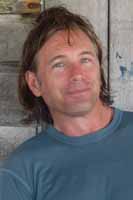 Dr.
Wallace J Nichols, or "J" as his friends call him, joined us in the Anambas
Islands in March. J speaks
softly and gently, but with words that strike to the core of an issue
and leave you with the understanding that he is fiercely passionate
about the protection of the environment, community conservation and a
concern for the seven species of sea turtles that are all endangered. With J
in hand, we met with school children, fisherman and the local government
to discuss the future of sea turtles in Anambas, hear of their concerns
and learn about their decline. Dr.
Wallace J Nichols, or "J" as his friends call him, joined us in the Anambas
Islands in March. J speaks
softly and gently, but with words that strike to the core of an issue
and leave you with the understanding that he is fiercely passionate
about the protection of the environment, community conservation and a
concern for the seven species of sea turtles that are all endangered. With J
in hand, we met with school children, fisherman and the local government
to discuss the future of sea turtles in Anambas, hear of their concerns
and learn about their decline.
There are at least two species
of sea turtles that nest on several beaches in Anambas – hawksbill and
green turtles.
Green turtles eat mostly jellyfish, migrate
to distant shores, feed in one location and nest in another. Hawksbill
turtles general migrate less, eating primarily sponges and sea grass
while nesting in the same geographic area. Sea turtles are important to
reef and marine ecology. They tend lagoon gardens and coral reefs, the
“rainforests of the sea.”
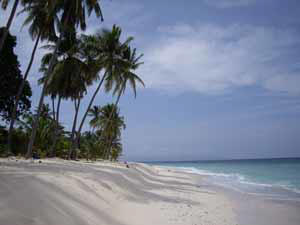
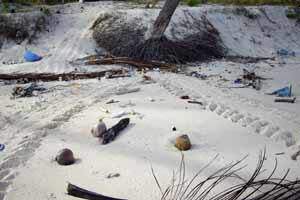
Durai
Beach
Green Turtle Tracks
Durai Island, just northwest of Terempah, is about ½ a
mile long and is the nesting home of both species. Thousands of nesting
turtles arrive there throughout the year; the peak season lies between
July and September. Both green and hawksbill turtles nest together, at
night, laying a hundred or more eggs in large holes on the beach.
Hatchlings emerge about 2 months later usually at night or in the early
morning light.
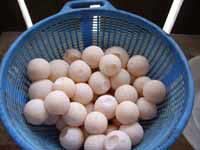 Sea turtles are endangered around the world because
most cultures ate, or are still eating, turtles and their eggs. Like
humans, turtles live long. They don’t mature to have eggs until they are
about 20 years old or more, but every three years, or so, they will
continue to produce eggs until their death at around 80 years. If the
turtle survives the incubation period and hatches, the most challenging
time in its life commences: it must make its way out of the nest, down
to the shoreline and across the reef where fish, birds and other prey
are waiting. Once past the reef, only then does the turtle have some
chance to survive in the vast wide-open sea. Sea turtles are endangered around the world because
most cultures ate, or are still eating, turtles and their eggs. Like
humans, turtles live long. They don’t mature to have eggs until they are
about 20 years old or more, but every three years, or so, they will
continue to produce eggs until their death at around 80 years. If the
turtle survives the incubation period and hatches, the most challenging
time in its life commences: it must make its way out of the nest, down
to the shoreline and across the reef where fish, birds and other prey
are waiting. Once past the reef, only then does the turtle have some
chance to survive in the vast wide-open sea.
For the turtles in Anambas,
most never make it to hatching.
Almost 100% of the eggs are diligently
gathered the night they are laid and sold at the local market within 24
hours. The eggs are then boiled and unlike a chicken egg, the contents
are sucked out of the soft leathery shell. Allegedly, some people also
catch adult turtles, cook them and eat the meat using its shell as a
bowl. Years of harvesting the eggs have taken their toll and now these
sea animals are disappearing.
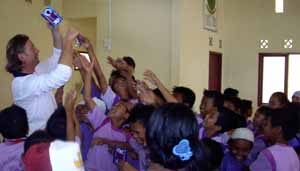
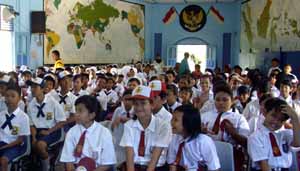
Thankfully, the people of
Anambas care. School children ran unabashed towards J enthusiastically
wishing to join the first “sea turtle club” in Anambas. Town council
members offered to help us establish a sea turtle conservation program
and ushered us to visit with Dr. T. Mukhtaruddin, Bupati Anambas (Head
of the Anambas Region) to win his support. It is incredibly fortuitous
that we have become friends with a remarkable woman, Ibu Nina Marliana,
Head of Premier Oil’s Community Development Program. With the support of
Francis Lee at Raffles Marina and Dr. Aji Sularso, Director General of
Surveillance and Control of Marine Resources & Fisheries in Jakarta, we hope to protect
Durai
Island
and work with the Anambas Government to steward its first marine
protected area.
Jointly we hope that this program will
become a center for education and skill-based training for people to
learn how to become helpful stewards of the oceans and its beautiful sea
turtles.
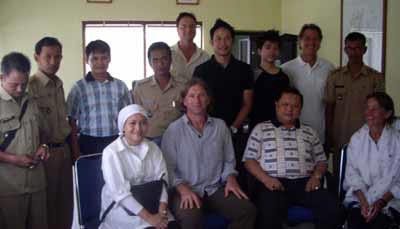
Ibu Nina Marliana, Dr. Wallace J
Nichols and Dr. T. Mukhtaruddin, Bupati Anambas with other members of the
Anambas Council, Premier Oil and Biosphere Foundation.
|
|










